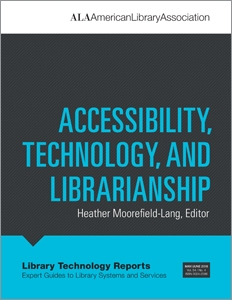Primary tabs
You don't need to be an ALA Member to purchase from the ALA Store, but you'll be asked to create an online account/profile during checkout to proceed. This Web Account is for both Members and non-Members. Note that your ALA Member discount will be applied at the final step of the checkout process.
If you are Tax-Exempt, please verify that your account is currently set up as exempt before placing your order, as our new fulfillment center will need current documentation. Learn how to verify here.
- Description
- Table of Contents
- About the authors
This issue of Library Technology Reports (vol. 54, no. 4) looks into the wide definition of accessibility for library patrons within the area of instruction. This topic is discussed in some depth in schools of library science as well as in faculty development and instructional design. This report will encourage readers to think more critically about the technologies that faculty and staff use to address the needs of all patrons served. This report will also aid in identifying and using new methods for addressing the needs of all patrons through a wide range of modalities (closed-captioning, transcription, video, text to speech, image to text, etc.).
This contributed work will examine accessibility, technology, and librarianship across a wide spectrum. Ida Mae Craddock will discuss using virtual reality and Google Expeditions with second language learners. Helen Turner and Patrick Lee Lucas will delve into universal design and providing equitable access to students in the University of Kentucky’s College of Design. George Shaw will investigate instruction and access for students taking an online computer programming course. Robert Browder will discuss how to make library materials accessible to readers through PDF scanning. Stacy Brown will discuss the impact of littleBits with students at the K–12 level in libraries. Aisha S. Haynes will examine Quality Matters accessibility measures, online instruction, library partnerships, and professional development. Stacy Hammer will complete the report with a look into the differentiation of instruction in libraries and how technology can be used with students in the K–12 setting.
Chapter 1—Introduction
Heather Moorefield-Lang
Chapter 2—Immersive Virtual Reality, Google Expeditions, and English Language Learning
Ida Mae Craddock
Chapter 3—Curating Technology for Learning: A Faculty View
Helen Turner and Patrick Lee Lucas
Chapter 4—Exploring the Development of Deeper Learning Skills: A Case Study Analysis of a Python E-learning Course
George Shaw, Jr.
Chapter 5—Scanning Print to PDF: Opportunities and Obstacles for Screen Reader Accessibility
Robert Browder
Chapter 6—Big Impact with littleBits
Stacy Brown
Chapter 7—Identifying and Removing Barriers: How Campus Partners Cultivate Diverse Online Learning Environments
Aisha S. Haynes
Chapter 8—Access through Universal Design and Technology
Stacy Hammer
Edited by Heather Moorefield-Lang
Heather Moorefield-Lang is an associate professor at the University of South Carolina in the School of Library and Information Science. Her research is focused on emerging technologies and their use in education and libraries. Her current research focuses on makerspaces and their integrated technologies in libraries of all types and levels.
Library Technology Reports
Published by ALA TechSource, Library Technology Reports helps librarians make informed decisions about technology products and projects. Library Technology Reports publishes eight issues annually and provides thorough overviews of current technology. Reports are authored by experts in the field and may address the application of technology to library services, offer evaluative descriptions of specific products or product classes, or cover emerging technology. Find out more information on this publication and how you can subscribe here.



